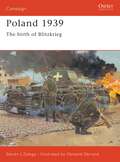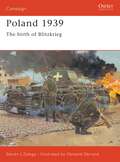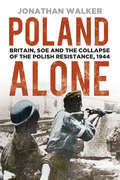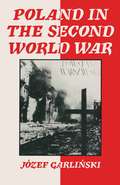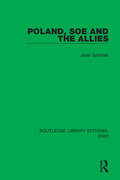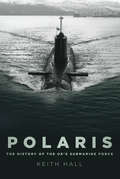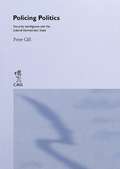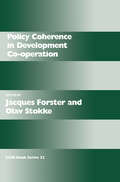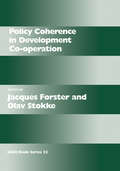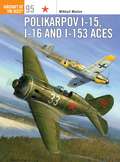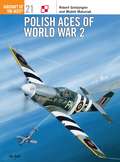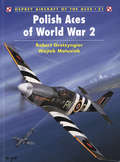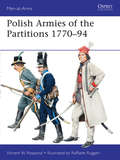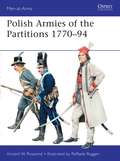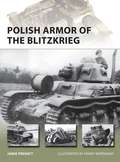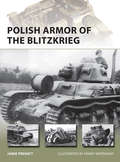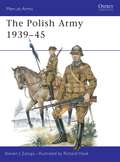- Table View
- List View
Poland 1939: The birth of Blitzkrieg (Campaign)
by Steven J. ZalogaThe German invasion of Poland on 1 September 1939 began World War II in Europe, pitting the newly modernized army of Europe's great industrial power against the much smaller Polish army and introducing the world to a new style of warfare – Blitzkrieg. Panzer divisions spearheaded the German assault with Stuka dive-bombers prowling ahead spreading terror and mayhem. This book demonstrates how the Polish army was not as backward as it is often portrayed and fielded a tank force larger than that of the contemporary US Army. Its stubborn defence did give the Germans some surprises and German casualties were relatively heavy for such a short campaign.
Poland 1939: The birth of Blitzkrieg (Campaign)
by Steven J. ZalogaThe German invasion of Poland on 1 September 1939 began World War II in Europe, pitting the newly modernized army of Europe's great industrial power against the much smaller Polish army and introducing the world to a new style of warfare – Blitzkrieg. Panzer divisions spearheaded the German assault with Stuka dive-bombers prowling ahead spreading terror and mayhem. This book demonstrates how the Polish army was not as backward as it is often portrayed and fielded a tank force larger than that of the contemporary US Army. Its stubborn defence did give the Germans some surprises and German casualties were relatively heavy for such a short campaign.
Poland Alone: Britain, SOE and the Collapse of the Polish Resistance, 1944
by Jonathan WalkerPOLAND was the ‘tripwire’ that brought Britain into the Second World War, but neither Britain nor Poland’s older ally, France, had the military means to prevent Poland being overrun, and the broadcast, ‘Poland is no longer alone’ had a distinctly hollow ring. During the next five years the Polish Government-in-exile and armed forces made a significant contribution to the Allied war effort; in return the Polish Underground (Home Army) received only paltry quantities of supplies and men. Using veterans’ testimonies and previously classified material, Jonathan Walker examines the heroic attempts by elements of SOE and the RAF to aid the Poles, against a background of Allied inertia and calculating Soviet ambition. The war ended with over six million Poles dead, the crushing of their resistance movement and their culture, and the imposition of Soviet control. What more could Britain have done to help her loyal ally?
Poland, SOE and the Allies (Routledge Library Editions: WW2 #24)
by Jozef GarlinskiThis book, first published in 1969, discusses objectively the tragic wartime position of Poland, having both the Nazis and Soviets as enemies – the war opened with the country being invaded by both. The book examines the work of the Polish underground army (Home Army) and its cooperation with SOE in providing intelligence of German movements – plans for attacking the Soviet Union, and experiments with V2 rockets. It also gives special attention to the Warsaw Rising and the political and military problems connected with it.
Poland, SOE and the Allies (Routledge Library Editions: WW2 #24)
by Jozef GarlinskiThis book, first published in 1969, discusses objectively the tragic wartime position of Poland, having both the Nazis and Soviets as enemies – the war opened with the country being invaded by both. The book examines the work of the Polish underground army (Home Army) and its cooperation with SOE in providing intelligence of German movements – plans for attacking the Soviet Union, and experiments with V2 rockets. It also gives special attention to the Warsaw Rising and the political and military problems connected with it.
Poland's Place in Europe: General Sikorski and the Origin of the Oder-Neisse Line, 1939-1943
by Sarah Meiklejohn TerryThe author explores a variety of questions related to General Sikorski's policies, such as his effort to maintain an independent Polish Arms' in the Soviet Union. Drawing on extensive British, American, and Polish archives, her work describes the defeat of a radical solution to the perennial instability of Central Europe.Originally published in 1983.The Princeton Legacy Library uses the latest print-on-demand technology to again make available previously out-of-print books from the distinguished backlist of Princeton University Press. These editions preserve the original texts of these important books while presenting them in durable paperback and hardcover editions. The goal of the Princeton Legacy Library is to vastly increase access to the rich scholarly heritage found in the thousands of books published by Princeton University Press since its founding in 1905.
Polaris: The History of the UK’s Submarine Force
by Keith HallBetween 15 June 1968 and 13 May 1996, the Polaris submarines of the 10th Submarine Squadron carried out a total of 229 patrols, travelling over 2 million miles. Wherever you sit on the nuclear debate, it makes an impressive tale; delivered on time and on budget essentially by a small group of naval officers and civil servants, the Polaris programme ensured that Britain had a Continuous at Sea Deterrence for twenty-eight years. Polaris is not just the history of the weapons, submarines and politicians: it is the history of those who were there. Combining through history with personal memories and photographs, Keith Hall has created a long-lasting legacy to a fascinating project and provided an insight into a world that no longer exists.
The Polaris Protocol: A gripping military thriller from ex-Special Forces Commander Brad Taylor (Taskforce #5)
by Brad TaylorYou think you know your enemy. Until you don't. The Taskforce – a highly classified Special Forces unit – has been sent to investigate a Mexican drug cartel. Yet they uncover something more insidious than drug trafficking. The cartel has discovered a way to penetrate the GPS tracking system, capable of putting the US on standstill. The system sends out false GPS signals, enabling a user to manipulate everything from banking systems to cruise missiles. The Taskforce sends Pike Logan to infiltrate the cartel's inner circle. They must eliminate the impending threat, before the cartel cripples the entire country. Praise for Brad Taylor: 'It's an excellent read, and I greatly enjoyed it' Nelson DeMille. 'Pike ranks right up there with Jason Bourne, Jack Reacher and Jack Bauer' John Lescroart. 'Logan is a tough, appealing hero you're sure to root for' Joseph Finder. 'Fresh plot, great actions, and Taylor clearly knows what he is writing about' Vince Flynn.
Policing Politics: Security Intelligence and the Liberal Democratic State (Studies in Intelligence)
by Peter GillNumerous allegations of abuse of power have been made against the domestic security intelligence agencies in the United Kingdom such as police special branches and MI5. These include the improper surveillance of trade unionists and peace activists, campaigns of mis-information against elected politicians and even the elimination' of people believed to be engaged in political violence. Drawing on extensive foreign material and making use of the social science concepts of information, power and law, this book develops a framework for the comparative analysis of these agencies.
Policing Politics: Security Intelligence and the Liberal Democratic State (Studies in Intelligence)
by Peter GillNumerous allegations of abuse of power have been made against the domestic security intelligence agencies in the United Kingdom such as police special branches and MI5. These include the improper surveillance of trade unionists and peace activists, campaigns of mis-information against elected politicians and even the elimination' of people believed to be engaged in political violence. Drawing on extensive foreign material and making use of the social science concepts of information, power and law, this book develops a framework for the comparative analysis of these agencies.
Policing the Home Front 1914-1918: The control of the British population at war (Routledge Studies in First World War History)
by Mary FraserThe civilian police during the First World War in Great Britain were central to the control of the population at home. This book will show the detail and challenges of police work during the First World War and how this impacted on ordinary people’s daily lives. The aim is to tell the story of the police as they saw themselves through the pages of their best-known journal, The Police Review and Parade Gossip, in addition to a wide range of other published, archival and private sources.
Policing the Home Front 1914-1918: The control of the British population at war (Routledge Studies in First World War History)
by Mary FraserThe civilian police during the First World War in Great Britain were central to the control of the population at home. This book will show the detail and challenges of police work during the First World War and how this impacted on ordinary people’s daily lives. The aim is to tell the story of the police as they saw themselves through the pages of their best-known journal, The Police Review and Parade Gossip, in addition to a wide range of other published, archival and private sources.
Policy Coherence in Development Co-operation (Routledge Research EADI Studies in Development #8)
by Jacques Forster Olav StokkeIn the 1990s, a shared conviction emerged among aid donors that their policies should be more coherent. The drive towards increased policy coherence came as a response to a state of policy incoherence. The shifting grounds of policy coherence in development co-operation are outlined in this volume.
Policy Coherence in Development Co-operation (Routledge Research EADI Studies in Development)
by Jacques Forster Olav Schram StokkeIn the 1990s, a shared conviction emerged among aid donors that their policies should be more coherent. The drive towards increased policy coherence came as a response to a state of policy incoherence. The shifting grounds of policy coherence in development co-operation are outlined in this volume.
Polikarpov I-15, I-16 and I-153 Aces (Aircraft of the Aces #95)
by Mikhail Maslov Mr Mark PostlethwaiteThe I-15, I-16 and I-153 fighters were the world's first mass-produced fighters. Some 17,000 Polikarpovs had been manufactured by the time production ceased in 1941. They served with the Republicans in the Spain, the Chinese against Japan in 1937–38, and the Soviets against both Japan in the Nomonhan Incident and Finland during the Winter War. By 1941, more than 20 Soviet pilots had made ace in Polikarpovs, and many more attained that status during the first months of the German invasion. Though thoroughly outclassed, the Polikarpov was the backbone of the Soviet air force during the early months of the war in the east, and continued to serve, as training aircraft and as frontline fighters, some right through to 1945.
Polikarpov I-15, I-16 and I-153 Aces (Aircraft of the Aces)
by Mark Postlethwaite Mikhail MaslovThe I-15, I-16 and I-153 fighters were the world's first mass-produced fighters. Some 17,000 Polikarpovs had been manufactured by the time production ceased in 1941. They served with the Republicans in the Spain, the Chinese against Japan in 1937–38, and the Soviets against both Japan in the Nomonhan Incident and Finland during the Winter War. By 1941, more than 20 Soviet pilots had made ace in Polikarpovs, and many more attained that status during the first months of the German invasion. Though thoroughly outclassed, the Polikarpov was the backbone of the Soviet air force during the early months of the war in the east, and continued to serve, as training aircraft and as frontline fighters, some right through to 1945.
Polish Aces of World War 2 (Aircraft of the Aces)
by Robert GretzyngierPilots of the Polish Air Force saw action from the first day of World War 2 until the final victory in Europe. Flying hopelessly outmoded P.11 fighters in defence of their country in September 1939, a handful of aviators inflicted serious losses on the Luftwaffe before being overwhelmed. The survivors escaped to then neutral Hungary and Romania, before being ordered to France by the new C-in-C of exiled Polish Armed Forces, General Sikorski. With the invasion of Western Europe in May 1940, the surviving pilots were once more thrust into desperate action in newly-formed Polish units
Polish Aces of World War 2 (Aircraft of the Aces)
by Robert GretzyngierPilots of the Polish Air Force saw action from the first day of World War 2 until the final victory in Europe. Flying hopelessly outmoded P.11 fighters in defence of their country in September 1939, a handful of aviators inflicted serious losses on the Luftwaffe before being overwhelmed. The survivors escaped to then neutral Hungary and Romania, before being ordered to France by the new C-in-C of exiled Polish Armed Forces, General Sikorski. With the invasion of Western Europe in May 1940, the surviving pilots were once more thrust into desperate action in newly-formed Polish units
Polish Armies of the Partitions 1770–94 (Men-at-Arms #485)
by Vincent W. Rospond Mr Raffaele RuggeriThe tragic national epic of Polish history began in these late 18th-century wars. Under Poland's Saxon monarchy, Russia and Prussia constantly meddled in the affairs of the Kingdom. In 1768 a civil war broke out between pro-Russian 'Commonwealth' Poles and 'Confederate' patriots who opposed foreign intervention; Russia intervened directly, and the First Partition followed in 1772. Guerrilla resistance continued, and anti-Russian political moves were snuffed out by a second Russian invasion in 1792. Following a Second Partition between Russia and Prussia in 1793, Poland's national hero Thaddeus Kosciusko led a national uprising against the invaders in April 1794. After remarkable victories against the odds at Raclawice and Warsaw, the patriots were finally defeated by the combined armies of Prussia and Russia at Maciejowice. This led to the Third Partition of 1795, between Prussia, Russia, and Austria, and Poland ceased to exist as a political nation. Featuring specially commissioned full-color illustrations, this is the epic story of Poland's doomed struggle to remain independent in the face of aggression from its neighbours in the late 18th century.
Polish Armies of the Partitions 1770–94 (Men-at-Arms #485)
by Raffaele Ruggeri Vincent W. RospondThe tragic national epic of Polish history began in these late 18th-century wars. Under Poland's Saxon monarchy, Russia and Prussia constantly meddled in the affairs of the Kingdom. In 1768 a civil war broke out between pro-Russian 'Commonwealth' Poles and 'Confederate' patriots who opposed foreign intervention; Russia intervened directly, and the First Partition followed in 1772. Guerrilla resistance continued, and anti-Russian political moves were snuffed out by a second Russian invasion in 1792. Following a Second Partition between Russia and Prussia in 1793, Poland's national hero Thaddeus Kosciusko led a national uprising against the invaders in April 1794. After remarkable victories against the odds at Raclawice and Warsaw, the patriots were finally defeated by the combined armies of Prussia and Russia at Maciejowice. This led to the Third Partition of 1795, between Prussia, Russia, and Austria, and Poland ceased to exist as a political nation. Featuring specially commissioned full-color illustrations, this is the epic story of Poland's doomed struggle to remain independent in the face of aggression from its neighbours in the late 18th century.
Polish Armor of the Blitzkrieg (New Vanguard)
by Henry Morshead Jamie PrenattThe Polish army during the Blitzkrieg conjures up tragic images of infantry and dashing, but ineffective and ultimately doomed cavalry charges. In actuality the Poles, in the midst of a large-scale re-armament programme, had up to 600 armoured vehicles available at the time of the German attack, as well as a number of newer and better designs in various stages of development. Facing the inventors of the 'Lightning War', who attacked in great numbers, on multiple fronts and with total mastery of the air, the Polish armoured formations were up against it. But outdated equipment, doctrine and enormous odds did not stop these units from fighting with bravery and determination before being finally overwhelmed. This volume is a complete technical study of the machines that formed the backbone of Poland's defences on the ground, using never-before-seen photographs and a comprehensive design and developmental history that reveal a full picture of Poland's armoured forces in the context of their greatest challenge.
Polish Armor of the Blitzkrieg (New Vanguard #224)
by Jamie Prenatt Mr Henry MorsheadThe Polish army during the Blitzkrieg conjures up tragic images of infantry and dashing, but ineffective and ultimately doomed cavalry charges. In actuality the Poles, in the midst of a large-scale re-armament programme, had up to 600 armoured vehicles available at the time of the German attack, as well as a number of newer and better designs in various stages of development. Facing the inventors of the 'Lightning War', who attacked in great numbers, on multiple fronts and with total mastery of the air, the Polish armoured formations were up against it. But outdated equipment, doctrine and enormous odds did not stop these units from fighting with bravery and determination before being finally overwhelmed. This volume is a complete technical study of the machines that formed the backbone of Poland's defences on the ground, using never-before-seen photographs and a comprehensive design and developmental history that reveal a full picture of Poland's armoured forces in the context of their greatest challenge.
The Polish Army 1939–45 (Men-at-Arms #117)
by Steven J. Zaloga Richard HookPoland was the first of the Allied nations to succumb to German aggression in the Second World War, but by the most tortuous of routes her army managed to remain in the field through all five years of bloody fighting. Polish soldiers fought in nearly every major campaign in the European theatre, and their tale is a complicated and tragic one. This richly detailed text by Steven Zaloga relates the story of the Polish Army during the Second World War, from the first wave of Stukas in 1939 to its eventual conclusion.
The Polish Army 1939–45 (Men-at-Arms #117)
by Steven J. Zaloga Richard HookPoland was the first of the Allied nations to succumb to German aggression in the Second World War, but by the most tortuous of routes her army managed to remain in the field through all five years of bloody fighting. Polish soldiers fought in nearly every major campaign in the European theatre, and their tale is a complicated and tragic one. This richly detailed text by Steven Zaloga relates the story of the Polish Army during the Second World War, from the first wave of Stukas in 1939 to its eventual conclusion.
